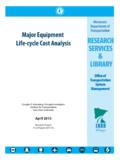Transcription of State income and franchise tax - EY - United States
1 To our readersThe following provides a summary of the significant legislative, administrative and judicial actions that affected State and local income / franchise taxes during the period from April 1, 2017 through June 19, quarter 2017 State income and franchise tax developmentsConnect with usFollow us on Twitter at: @EY_USStateTaxClick here for the latest on federal tax reform. Key developmentsPage 2 California FTB ruling applies IRC Sections 382-384 valuation limitations for net operating losses and tax credits on a pre-apportioned basisPage 2 California legislature approves bill to overhaul State Board of Equalization, establish new State tax department, Governor s approval expected shortlyPage 3 Tennessee enacts single sales factor election for manufacturersOther noteworthy developmentsPage 3 Legislative developments in Alabama, ColoradoPage 4 Legislative developments in Florida, Georgia, Iowa, Maine, Minnesota, Montana and NebraskaPage 5 Legislative developments in New Mexico, New York, Oklahoma, Oregon, Philadelphia (PA)
2 , South Carolina, Texas and VermontPage 5 Judicial developments in Iowa and MichiganPage 6 Judicial developments in Minnesota, New Jersey, Oregon and TexasPage 6 Administrative developments in CaliforniaPage 7 Administrative developments in Connecticut, Michigan, New Mexico and New York CityDevelopments to watchPage 7 Developments to watch in California and New York Page 8 Developments to watch in North Carolina, Oregon, Pennsylvania and TexasState income and franchise taxQuarterly update2| State income and franchise tax quarterly updateKey developmentsCalifornia FTB ruling applies IRC Sections 382-384 valuation limitations for net operating losses and tax credits on a pre-apportioned basis The California franchise Tax Board (FTB) in Technical Advice Memorandum (TAM) 2017 03 (April 6, 2017) provides guidance on the application of the loss limitation rules under Internal Revenue Code (IRC) Sections 382, 383 and 384 for California tax purposes as it relates to apportioning taxpayers, and provides guidance to California taxpayers that have tax attributes ( , net operating losses (NOLs) and tax credits) and have undergone an ownership change such that the attributes are subject to valuation the publication of the TAM, while California s tax law generally conformed to provisions of Subchapter C of the IRC ( , IRC Sections 301-385), neither California tax law nor the FTB provided guidance to taxpayers as to whether IRC Sections 382-384 applied on a pre-apportionment or post-apportionment the TAM, with respect to Section 382, the FTB determined that the limitation provided in Section 382(b)(1)
3 And the analogous limitation on the use of excess credits provided in Section 383(a)(1) are to be applied on a pre-apportioned basis. The FTB reasoned that because Section 382 does not address any items of income /deductions or gains/losses, apportionment could not apply to Section 382 absent express legislative action. Under California tax law and case authority, apportionment is only applied to items of income /deductions or gains/losses. As a result, the FTB concluded that Section 382 must be applied for California purposes on a pre-apportioned basis. Likewise and for the same reasons, the FTB concluded that the valuation limitation for credits under Section 383 must be applied on a pre-apportioned basis. The FTB pointed out that it had suggested a legislative proposal to apply Sections 382 and 383 on a post-apportioned basis but was unable to find a legislator that would agree to sponsor the legislation.
4 The FTB also spent considerable time distinguishing between California s legislative treatment of Section 382 loss limitations rules and those in other States that clearly adopted a post-apportionment analyzing the Section 382 provisions for net unrealized built-in gains/losses and recognized built-in gains/losses, however, the FTB concluded that because these were items of income /deductions or gains/losses, they should be applied on a post-apportioned basis under existing law. The FTB also applied this reasoning to California s treatment of recognized built-in gains set forth in Section California has not promulgated its own regulations addressing IRC Section 383, the IRS regulations should be applied, except to account for obvious differences, such as the federal income tax rate. California legislature approves bill to overhaul State Board of Equalization, establish new State tax department, Governor s approval expected shortlyOn the heels of a political scandal involving allegedly improper assignment of workers of the California State Board of Equalization (SBE), the California Legislature, as part of its budget package, approved a bill (AB 102) that would significantly minimize the powers of the SBE, transferring nearly all of its non-Constitutional powers to a new State Department of Tax and Fees (Department).
5 Governor Brown is expected to sign the legislation before July 1, 2017. In particular, under the bill the SBE s responsibility to hear appeals of personal income and corporate franchise and income tax matters from the FTB would be transferred to the new Department. The SBE would, however, retain its authority to regulate State assessed property granted by the California Constitution. In addition, the newly created Office of Tax Appeals would assume responsibility for the SBE s administrative tax appeals function and establish offices in Northern, Central and Southern California. Each tax appeals panel would be assigned three administrative law judges, who would be required to publish a written opinion for each & young LLP s insightsThe clarification on the valuation limitations for NOLs and tax credits is a long-awaited decision that presents an opportunity for California taxpayers to use a proportionately greater amount of tax attributes limited under Sections 382-384 than they might be able to use for federal income tax purposes.
6 Corporate taxpayers that have such limited attributes should evaluate their California tax attribute balances and consider whether the TAM could affect any valuation allowances. For additional information on this development, see Tax Alert | State income and franchise tax quarterly updateErnst & young LLP s insightsAlthough the Office of Tax Appeals would be created on July 1, 2017, the SBE would continue to hear tax appeals until January 1, 2018, to allow the Office of Tax Appeals time to employ judges and staff. AB 102 would add Cal. Gov. Cd. Section 15677, which provides that [t]he person filing the appeal may appeal the decision of the tax appeals panel to the superior court in accordance with the law imposing the tax or fee .. Since the FTB does not have the power to appeal matters to the Office of Tax Appeals, it appears, based on the aforementioned language, that the FTB would still, in effect, be precluded from appealing adverse decisions to the California superior court.
7 Taxpayers, on the other hand, would continue to retain the right to challenge an Office of Tax Appeals decision in court. If a taxpayer moves the tax matter into the court system, a new record would be created and the matter would be reviewed de novo, similar to the current process for SBE appeals under current is not known at this time whether appeals that have been filed with the current SBE and are fully briefed but have yet to be heard before the end of 2017 will simply convert over to the new tax appeals system or if new briefing will be required. Even with the additional six months to staff and implement procedures for the new agency, taxpayers can expect to experience delays in service as the new Department and the Office of Tax Appeals ramps up its staffing and enacts single sales factor election for manufacturersOn April 26, 2017, Governor Bill Haslam signed the Improving Manufacturing Public Roads and Opportunities for a Vibrant Economy (IMPROVE) Act (HB 534) into law.
8 A key provision of the Act permits a taxpayer whose principal business in Tennessee is manufacturing to elect single sales factor apportionment for purposes of both Tennessee's franchise and excise taxes. Under the new law, a taxpayer s principal business in Tennessee is manufacturing if more than 50% of the revenue excluding passive income derived from its activities in the State is from fabricating or processing tangible personal property for resale and consumption off the premises. The election is available for tax years starting on or after January 1, 2017, and once made is binding for five Act did not address how manufacturers that elect Single Sales Factor apportionment and are members of a Tennessee Consolidated Net Worth Election affiliated group should calculate franchise Tax; however, the Tennessee Department of Revenue (TN DOR) in Notice 17-11 (May 2017) provided guidance.
9 According to the TN DOR, such manufacturers will apportion Tennessee consolidated net worth by multiplying the group s consolidated net worth by the following fraction: the taxpayer s total sales in Tennessee over the affiliated group s total sales everywhere. Single sales factor apportionment only applies to the electing manufacturer. Non-manufacturers and manufacturers not making the election will continue to use the same apportionment formula they used prior to enactment of the Act. (The current standard apportionment formula consists of property, payroll and triple weighted sales factors).Other noteworthy developments LegislativeAlabama: HB 263, enacted April 20, 2017, requires loans and credit card receivables to be included in the calculation for the property factor of the financial institution excise tax apportionment formula. Loans and credit card receivables are sourced to Alabama using the same sourcing methods that the Alabama Department of Revenue uses to allocate and apportion a financial institution s interest receipts from related loans and credit card receivables.
10 This change applies to all tax years beginning on or after January 1, 2017. Colorado: ASB 299 (enacted June 5, 2017) establishes an apportionment method that may be used by an entity making a capital investment in an enterprise data center operation in Colorado and enters into a memorandum of understanding (MOU) with the Office of Economic Development (OED). Under these provisions, a qualifying entity s sales from services are Colorado sales to the extent such sales constitute revenues from services delivered to the entity s customer s Colorado location, as demonstrated by the customer s billing address. To qualify, an entity s capital investment in an enterprise data center must equal at least $150 million within any consecutive five-year period beginning on or after January 1, 2013. SB 299 also sets forth the information to be included in the MOU.

















